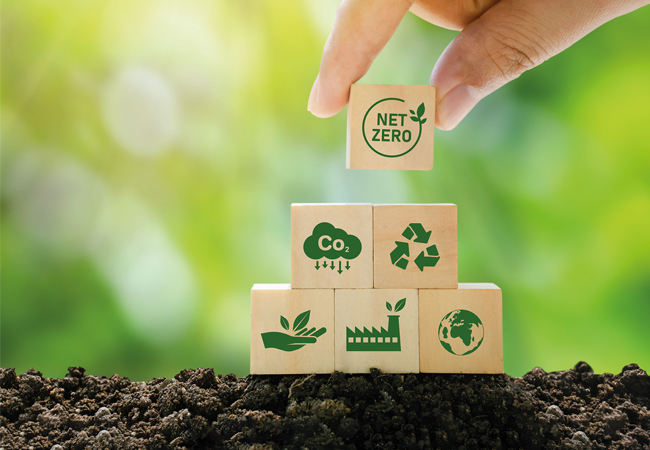
With extraordinary climatic1 and oceanic2 events filling the headlines, arguments3 raging over the opening up of further North Sea oil reserves, the viability of carbon capture and storage remaining uncertain,4 and the global construction of ‘low carbon’ offshore wind farms stalling,5 the time of the net zero building is undoubtedly here.
This CPD will explore some of the key drivers behind desperate calls for net zero buildings, and provides an overview of the recently published ASHRAE Standard 228 – which joins the increasingly congested knowledge space of how to guide and assure the swift move towards net zero built environments.
The existential threat of climate change is all around us. July 2023 was confirmed as the hottest month since records began in the 19th century, as United Nations (UN) secretary general Antonio Guterres proclaimed: ‘The era of global warming has ended. The era of global boiling has arrived.’6
Buildings are considered an essential part in the overall plan to reduce anthropogenic impact in an attempt to steady the climate, since the ‘burning of fossil fuels has emitted enough greenhouse gases to significantly alter the composition of the atmosphere and average world temperature has risen between 1.1 and 1.2°C’.7
The World Meteorological Organisation recently reported8 that the average global temperature in 2022 was about 1.15K above the 1850-1900 average (the benchmark period before the emission of greenhouse gases from human and industrial activities).
Between 2023 and 2027, it is predicted to reach between 1.1K and 1.8K higher. Ninety per cent of the global warming occurs in the oceans, as has been measured9 in recent decades, causing the water’s temperature to rise, so increasing its massive store of heat.
The record-breaking 2023 temperature rises in the North Atlantic are seen as part of natural variation within the climate system coming together to elevate sea-surface temperatures, although Professor Albert Klein Tank, head of the Met Office Hadley Centre noted: ‘It is not believed that these factors represent a climate-change-induced tipping point that produces runaway temperatures. However, they will add to climate and weather impacts this year.’10
In 2015, the UN Framework Convention on Climate Change (UNFCCC) adopted the Paris Agreement, which set a goal of limiting global warming to well below 2K – preferably to 1.5K – above pre-industrial levels. To limit global warming to 1.5K, greenhouse gas emissions must peak before 2025 at the latest, decline 43% by 2030 and reach net zero by 2050.11
To achieve this goal, the Paris Agreement, adopted at the 2016 UN Climate Change Conference (COP21), requires countries to submit their own national plans to reduce greenhouse gas emissions. However, seven years after the Paris Agreement – some two fifths of the way to 2050 – more than half the world’s nations have not been able to go beyond pledging a set of net zero policies, and nearly a quarter have no evidence of even having a proposal for net zero target (as shown in Figure 1).
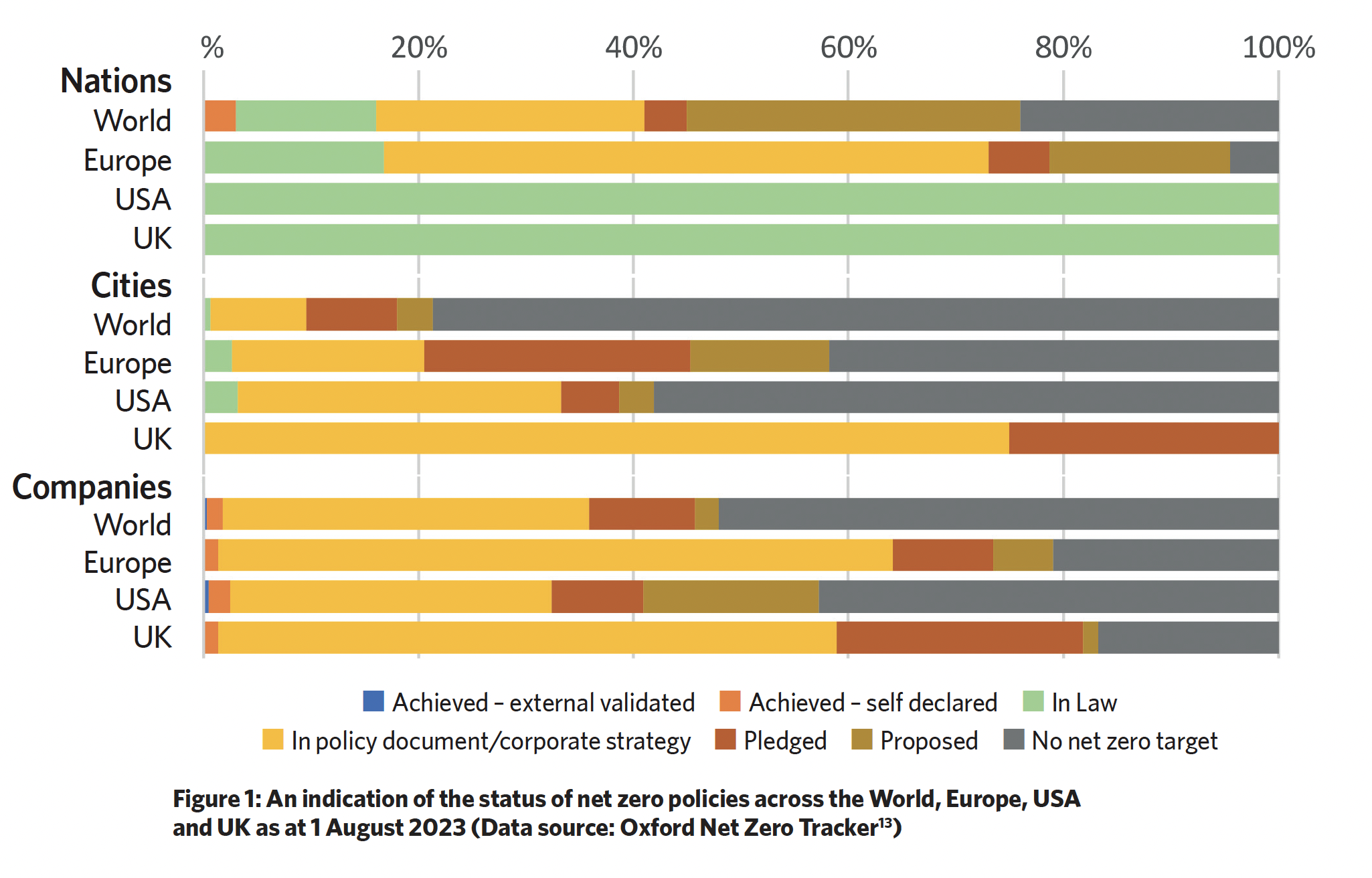
The 2022 UNEP report,12 released at COP27 in Sharm El Sheikh, reported that in 2021 the buildings and construction sector accounted for more than 34% of energy demand, and around 37% of energy- and process-related CO2 emissions, and that the sector’s 2021 operational energy-related CO2 emissions were up 5% over 2020 and 2% over the pre-pandemic peak in 2019. The report implores policymakers and decision-makers to ‘urgently implement definitive near-term actions that deliver the needed emissions reductions while achieving the objectives of a sustainable and resilient buildings and construction sector’.
The Global Buildings Climate Tracker14 (GBCT) tracks decarbonisation progress in the buildings sector, set at a value of 0 for 2015, the base year, and a target value of 100 in the year 2050, reflecting the maximum decarbonisation needed in the sector. As can be seen in Figure 2, the trajectory was not a promising one in the latest 2021 data, with a BCT value of 8.1– under half what might be expected on the linear path to a net zero built environment in 2050.
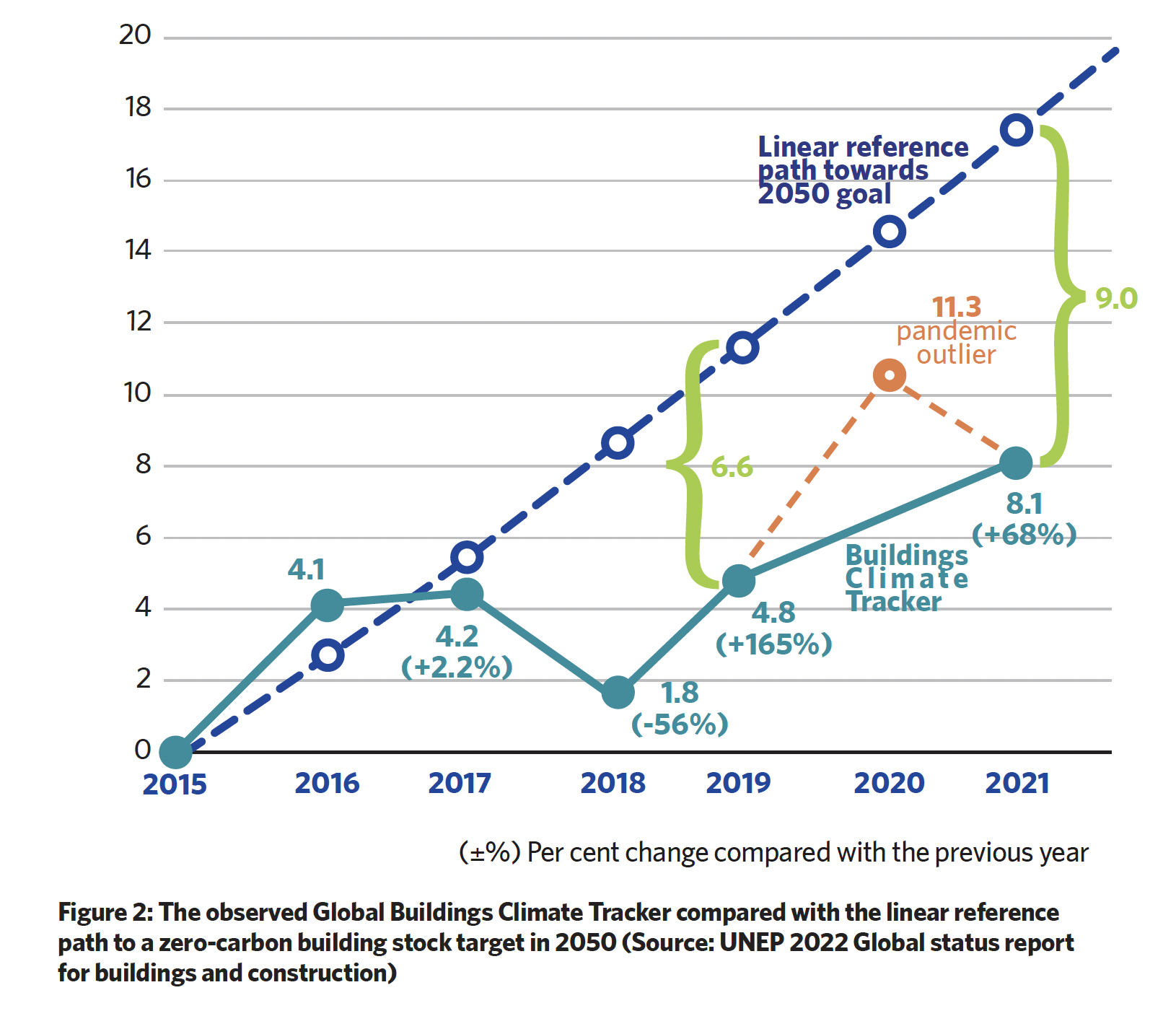
In terms of delivering significant near-term benefit, the adoption of net zero standards also encourages the adoption of innovative technologies and practices that minimise environmental footprints and operational energy costs. They typically drive investment in renewable energy sources, while optimising building envelope efficiency and HVAC systems. Net zero buildings are likely to be more comfortable and healthier to live and work in, thanks to features like better insulation and more controlled ventilation.
The financial investment in good quality net zero buildings has been shown15 to be sound, so it would appear that robust net zero building standards can deliver a win-win for the environment, public health, and the economy. So, although there are a number of net zero guides and standards in place, it would appear that none to date have wholly engaged the active interest of the professional teams – including the clients, owners and operators – who have responsibility for procuring and creating built environments.
In the UK, there is expectation that 2023 will see the publication of the first edition of the Net Zero Carbon Buildings Standard16 – a collaborative effort by leading professional organisations in the construction sector to create a single, agreed methodology. This standard aims to provide a comprehensive and accessible methodology to demonstrate net zero carbon performance in alignment with climate targets.
The standard’s steering group has just completed an open consultation on the key metrics required for evaluation, including the development of performance targets for new and existing buildings; carbon accounting methods; renewable energy assessment; and the role of carbon offsetting to address residual emissions. Notably, the standard’s principles and many of the methods are likely to be applicable worldwide. ASHRAE holds a significant place in engineering built environments around the world.
As such, the recent publication of ASHRAE Standard17 228 Standard Method of Evaluating Zero Net Energy and Zero Net Carbon Building Performance has excited interest for its potential to be applicable as a global tool to determine if a building or site has achieved net zero. It provides a generally simple compliance pro forma, with supporting data tables that, when completed with relevant data for a specific application at a particular location, indicates whether a building or development is likely to operate at net zero.
This generally uncomplicated approach could be extended beyond North America but, in this first edition, it is very much constrained to application in the US and Canada. In developing the standard, the committee took inspiration from ASHRAE Standard 105 (a standard that provides consistent methods for determining and reporting the energy performance of buildings); it decided to discourage the development of inefficient buildings that need significant amounts of onsite renewables in order to attain net zero – as well as acknowledging that many sites may not have sufficient opportunities for renewable energy production.
Notably, in a novel departure for ASHRAE, this standard relates to carbon equivalency as well as ASHRAE’s traditional realm of energy performance – in the many available global net zero publications, the focus is typically singularly on carbon. The standard’s project committee has also chosen to diverge from most other worldwide guides and standards by choosing to go with the US Department of Energy (USDOE)-favoured decarbonisation term by referring to ‘zero net carbon buildings’ rather than rather more common nomenclature of ‘net zero carbon buildings’.
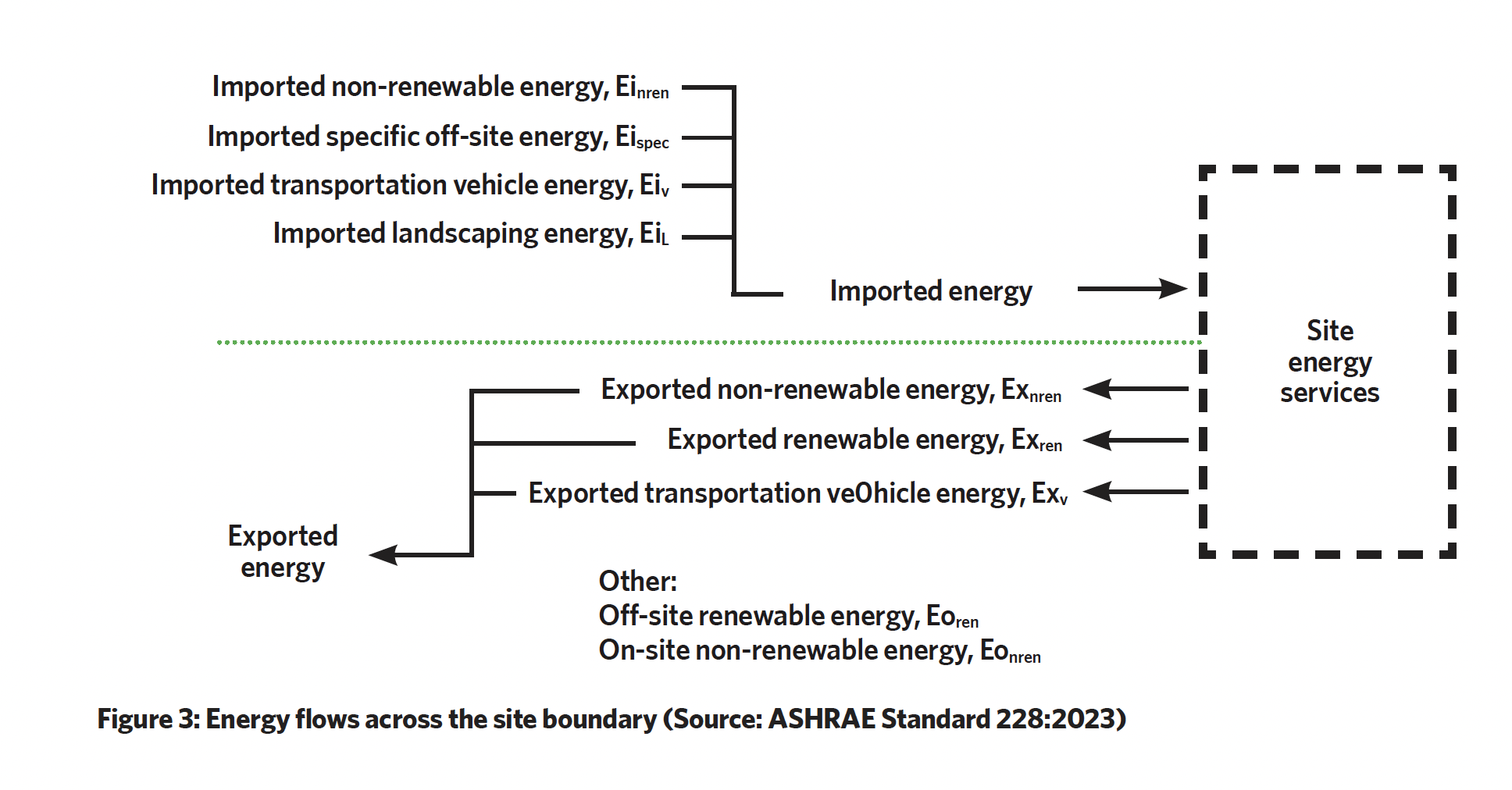
As illustrated in Figure 3, net zero is set as being principally based on the energy balance – and the resulting equivalent carbon – flowing into a site being equal to, or less than, that being exported during the operation of a building or site. Offsets may be included in the balance – albeit only those offsets that meet very closely qualified requirements. For example, the amount of procured off-site renewable energy is limited based on the gross floor area, the type of building and the ASHRAE climate zone (zones 1A to 8), and this offset must meet a set of highly prescriptive requirements relating to proof of ownership and longevity of an appropriately certificated supply.
And, as a final requirement, there must be evidence that any carbon offset projects will permanently sequester carbon for a minimum of 200 years. It would appear that offsetting is not considered as a frontrunner in the creation of a net zero development designed to meet this standard. The stringency of the offset requirements may in part be due to the somewhat unusual (and likely contentious) explicit inclusion of fuel oil and coal as a site energy source in the calculation tool, and the reality is such that such fossil fuels could practically only be used if there were some offset mechanism in place.
The project committee of ASHRAE Standard 228 has chosen not to include any embodied carbon in the assessment, although there is an explanatory appendix providing an introduction to embodied energy and carbon calculations. As discussed in CIBSE TM65,18 refrigerant leakage, throughout the building life-cycle, can have a significant impact on embodied carbon emissions and so will adversely impact the net zero aspirations of a building.
In recognition of this potential net zero disruptor, Standard 228 includes a simple calculation, supported by tables of global warming potential (GWP) for typical refrigerants and indicative typical annual refrigerant leakage rates for various applications (as shown in Table 1), which is then included in the overall carbon balance assessment for the building. The original source data that was used to create the table of refrigerant leakage as published in the standard has subsequently been updated by the authors (Barrault, S and Clodic, D19).
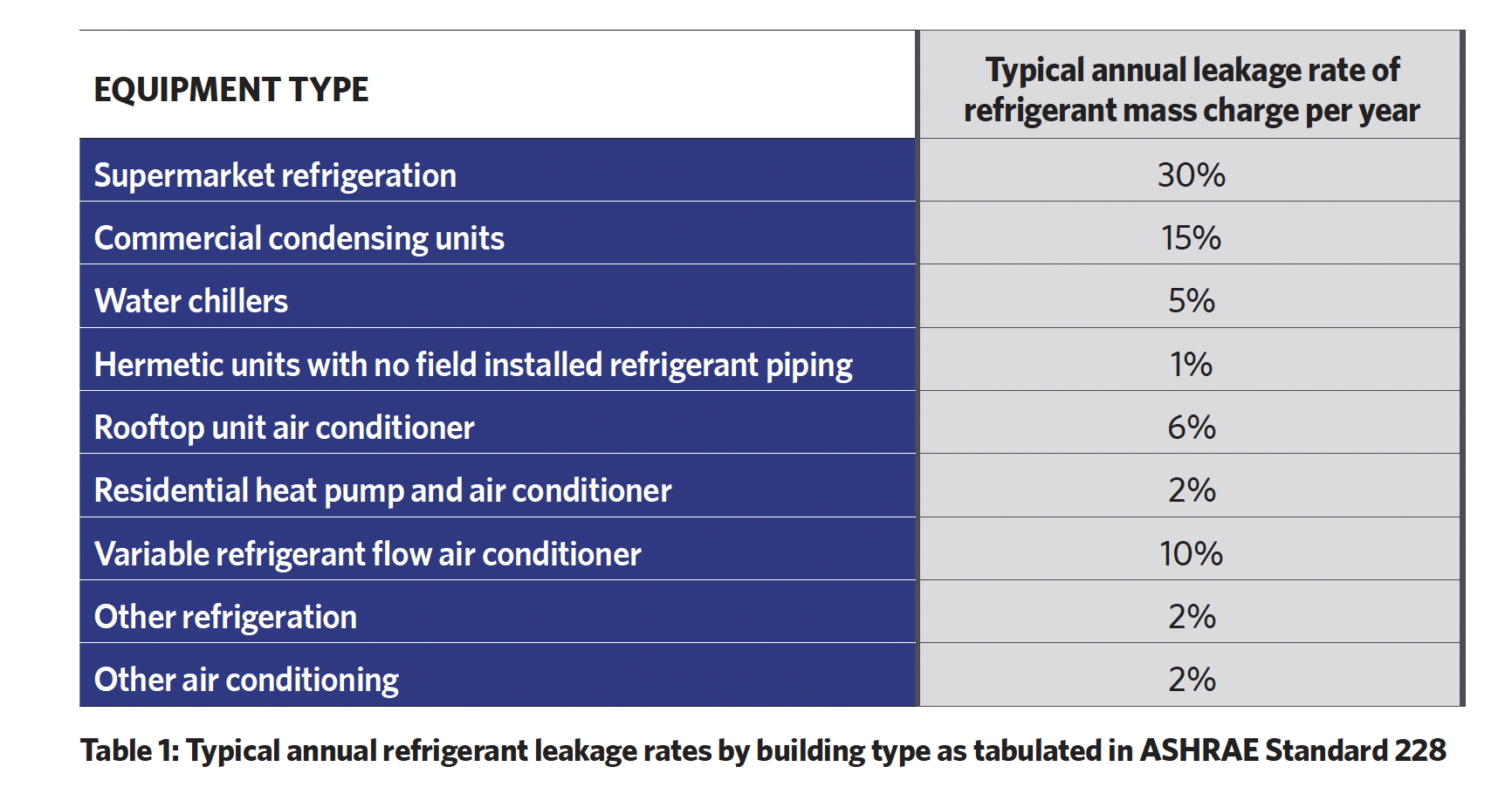
In the absence of other data, this could make an impact to the calculations, particularly significantly for variable refrigerant flow (VRF) systems. However, these tabulated values might legitimately be substituted by data that more properly represented the actual installation – the tabulated values may be considered as a ‘back-stop’ that are particularly useful at early stages of assessing the building’s carbon performance. In the foreword to Standard 228 it hints that embodied carbon will be fully included in a future edition.
The standard focuses on measuring and balancing energy and carbon flows across the site boundary. Any modelling for high-rise and non-residential existing and new buildings is required to conform with ASHRAE Standard 90.1, with no alternative methods offered. Energy assessments are defined in terms of the energy source, involving a range of multipliers being applied to the actual energy crossing the site boundary, to account for energy used or lost in the process of bringing the energy to site.
The standard includes tables of regional and energy source specific factors that are limited to US and Canada applications, but it would not seem unlikely that this could be expanded in due course to make the standard useable in other global regions. While the primary calculation is based on annual average factors, the standard includes the flexibility to employ hourly emission factors if such data is available. This provides a further opportunity to apply building (or location) data rather than the more general regional data as tabulated in the standard. The standard also details how to verify performance for parts of buildings, as well as portfolios and entire communities, where a collection of building sites are owned or leased by a single entity.
Despite the urgency of the shift to net zero built environments, it appears that globally applicable methods and technical standards from respected sources to assess a building’s holistic carbon credentials may still be in the pipeline. The simplicity of ASHRAE Standard 228 is somewhat overshadowed by being intrinsically linked to mandatory use of ASHRAE modelling methods, which is likely to limit its global application – the North American carbon factor data can, nevertheless, be readily internationalised. However, until it fully embraces embodied carbon, it will remain a tool that provides only partial intelligence on a building’s net zero performance that is based principally on site energy balance.
- bit.ly/CJSep23CPD1 – accessed 8 August 2023.
- bit.ly/CJSep23CPD2 – accessed 4 August 2023.
- bit.ly/CJSep23CPD3 – accessed 31 July 2023.
- bit.ly/CJSep23CPD4 – accessed 31 July 2023.
- bit.ly/CJSep23CPD5 – accessed 7 August 2023.
- bit.ly/CJSep23CPD6 – accessed 31 July 2023.
- bit.ly/CJSep23CPD7 – accessed 6 August 2023.
- bit.ly/CJSep23CPD8 – accessed 31 July 2023.
- bit.ly/CJSep23CPD9 – accessed July 31st 2023
- 1bit.ly/CJSep23CPD10 – accessed 31 July 2023.
- bit.ly/CJSep23CPD11 – accessed 31 July 2023.
- UNEP 2022 Global status report for buildings and construction, UNEP 2022.
- Net Zero Tracker, Energy and Climate Intelligence Unit, Data-Driven EnviroLab, NewClimate Institute, Oxford Net Zero. 2023 – accessed 31 July 2023.
- bit.ly/CJSep23CPD12 – accessed 31 July 2023.
- bit.ly/CJSep23CPD13 – accessed 31 July 2023.
- bit.ly/CJSep23CPD14
- ANSI/ASHRAE Standard 228-2023 Standard Method of Evaluating Zero Net Energy and Zero Net Carbon Building Performance.
- CIBSE TM 65 Embodied carbon in building services: A calculation methodology, CIBSE 2021.
- Barrault, S and Clodic, D, Inventaire des émissions de fluides frigorigènes France et DOM COM, année 2015 Rapport final, Centre Efficacité énergétique des Systèmes, February 2017.

